In this comprehensive exploration, we delve into the intricate world of Hyper-V, showcasing a collection of significant work and research dedicated to understanding and enhancing the security of Microsoft’s Hyper-V hypervisor.
From detailed proof-of-concept exploits to advanced debugging techniques, this article highlights the critical vulnerabilities discovered and the innovative tools developed for hypervisor research and fuzzing.
Join us as we navigate through the complexities of Hyper-V security, shedding light on its most pivotal aspects.
This repository contains some of the Hyper-V related work I did in the past…
GHHv6_ch25
My code from the “Inside Hyper-V” of the Gray Hat Hacking book (6th edition).
Original repository
Includes a framework that can be used to perform hypervisor research/fuzzing and hyper-v specific code (hypercalls, MSRs, VMBus communication).
windbg_hyperv_script.js
Windbg script that can be used when debugging hvix64 and provides the following features:
- Dumping VMCS contents.
- Dumping EPT tables.
- GPA -> SPA translation.
- Conditional breakpoints on VMExit conditions:
- Use
!brexit conditions. - Where
conditionsis a in the formcondition1 condition2 .. conditionN. - Each condition consists of 3 parts (in the described order and without space between them):
- A VMCS field name (for example
VM_EXIT_REASON) - A condition code: any of
==,!=,<=,>=,<,>. - An integer value.
- A VMCS field name (for example
- Use
CVE-2020-0751.c
Proof of concept for Hyper-V stack overflow bug (hvix64).
CVE-2020-0890.c
Proof of concept for Hyper-V NULL deref bug (hvix64).
CVE-2020-0904.c
Proof of concept for Hyper-V type confusion bug (hvix64).
CVE-2021-28476
Proof of concept for Hyper-V arbitrary memory read bug (vmswitch).
Notes:
- This bug was classified as RCE, learn why here.
- This bug has also been presented by other researchers.
- In the advisory I included other OOB read bugs I found but no CVEs were assigned to them.





















.webp)





.webp)
